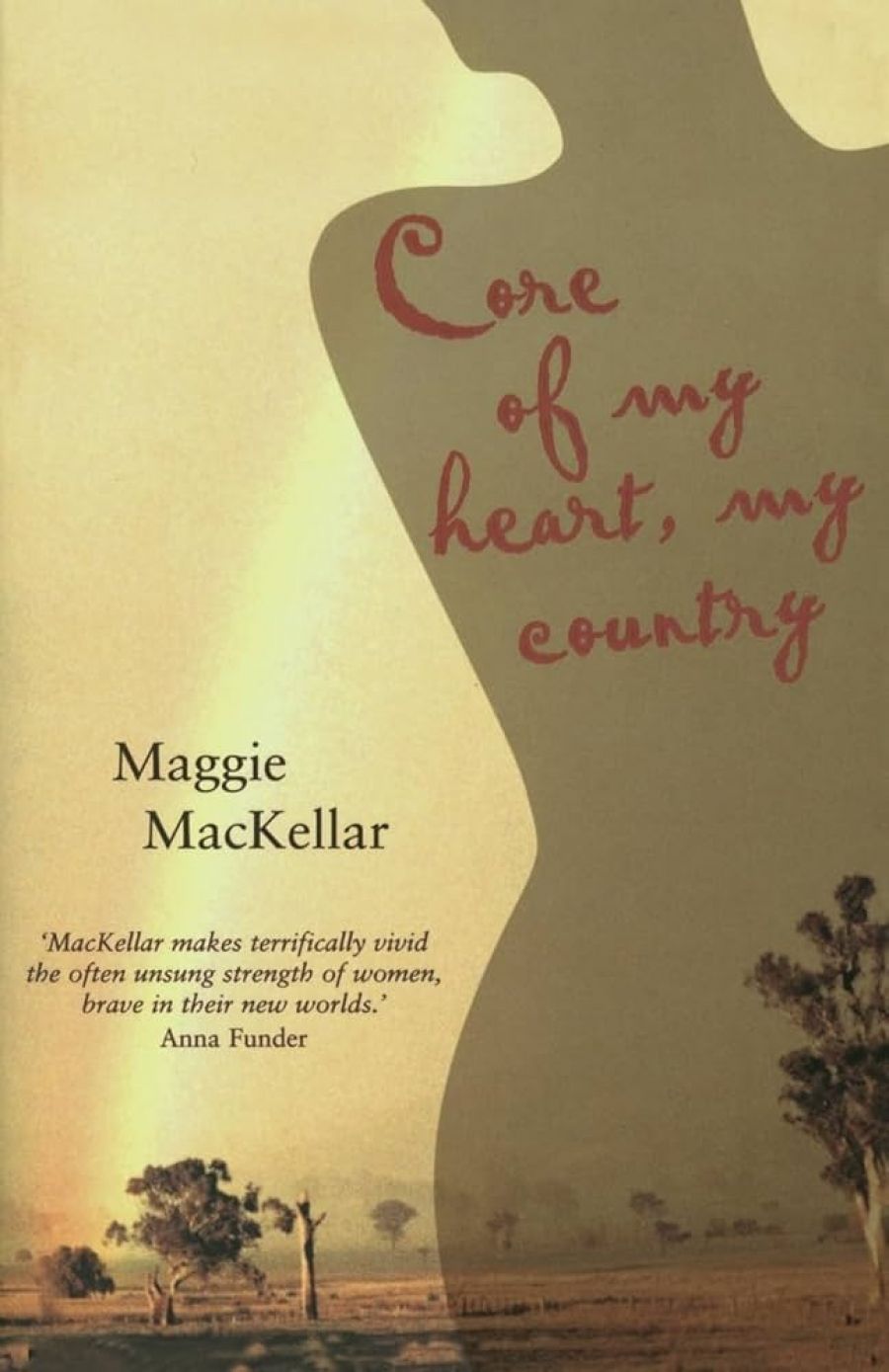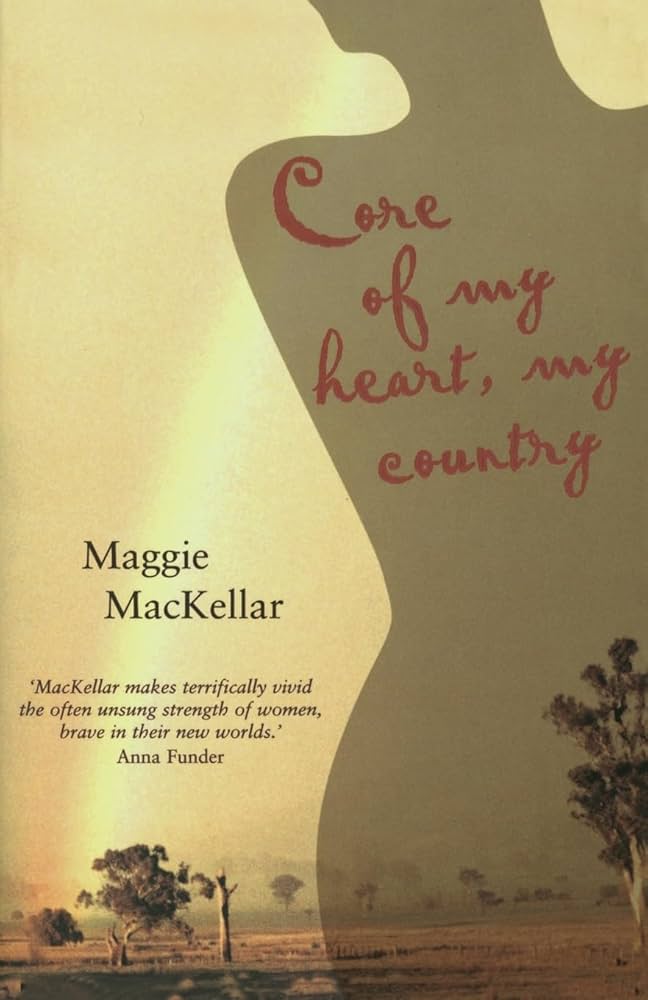
- Free Article: No
- Contents Category: History
- Review Article: Yes
- Article Title: Heartlands
- Online Only: No
- Custom Highlight Text:
In 1830, Georgiana Molloy stepped ashore at the remote settlement of Augusta, accompanying her husband to a new life in Western Australia. Maggie MacKellar tells us that:
Three weeks later, in the month of May, when in England spring bursts from every hedgerow, Georgiana lay on a plank of wood in her tent, with an umbrella held over her to keep off the drips that leaked in through the canvas. Outside the rain poured down. There was no sweet scent of spring; instead the air was filled with the rank, harsh smell of eucalyptus. Around her the earth opened itself to welcome the winter season. Racked with contraction after contraction, Georgiana fought to give birth to her first child.
- Book 1 Title: Core of My Heart, My Country
- Book 1 Subtitle: Women’s sense of place and the land in Australia and Canada
- Book 1 Biblio: MUP, $29.95 pb 341 pp
- Book 1 Cover Small (400 x 600):

- Book 1 Cover (800 x 1200):

Georgiana Molloy is just one of many memorable women whose stories are told in this vividly written study of women’s responses to the landscapes they encountered in Australia and Canada. Molloy’s connection to the natural world around her was forged through her experiences of bearing, raising and burying children in a new place, establishing the family homestead, and planting a domestic garden. But it was through her rumbles in pursuit of botanical specimens that Molloy came to ‘know’ and write about the ‘delights’ of the Australian bush
Through a careful reading of the letters, journals and memoirs of women such as Molloy, MacKellar seeks to challenge frontier myths that ‘silence and marginalise white women’s experience and their role in articulating how we “belong”’. Certainly, the cultural histories of both Australia and Canada are shaped by references to the inhospitality of ‘new world’ natural environments when it came to European efforts to clear forests, sow seeds and graze stock. The absence of familiar seasons and the foreignness of the landscape were, arguably, felt more acutely by white women in the overtly masculine world of these frontiers.
Northrop Frye summed up this settler dislocation as the ‘garrison mentality’ of the white Canadian imagination. In Australia, we need look no further than Henry Lawson’s ‘The Drover’ Wife’ or Barbara Baynton’s dark stories of bush life for images – whether heroic or despairing – of pioneer women trapped by their menfolk in a harsh and isolated existence. Yet, MacKellar informs us, there are other narratives about women’s relationship to place that are affirming and even celebratory. In reflecting on how generations of rural women in her own family relate to ‘special’ places, MacKellar argues that deep attachments between land and self are ‘born into us’, but also created through the power of language. Core of My Heart, My Country (the evocative title transposed from the famous poem of another Mackellar, Dorothea) explores this sense of being-in-place for Australian and Canadian women over the course of a century.
Packaged very handsomely by Melbourne University Press – in fact, looking more like a novel than a nonfiction text – this is an intensely personal book. It recounts the individual life stories of the historical women, and neatly interweaves these with MacKellar’s own feelings as she traverses the Alaskan wilderness, gazes into a glacial abyss, or confronts her own grief and ‘promise of life’ in the land around her. But MacKellar’s authorial presence never overwhelms. Her crisp and often lyrical prose carries the reader along at a cracking pace. In addition, the book’s message about the significance of place for non-indigenous Australians and Canadians has important political resonances in terms of broader questions about belonging in modern postcolonial societies.
MacKellar develops a striking argument regarding the importance of the horse. Riding gave women independence and, MacKellar suggests, ‘access to a more nuanced understanding of the connections between their bodies and the places where they lived’. Women in remote parts of Canada and Australia were always saddling up – an event so ordinary it was barely mentioned in the written accounts of the time. Side-saddle was mandatory for respectable middle-class women, at least in polite company, but riding astride offered greater freedom and comfort. Monica Hopkins, who migrated to the Canadian west in 1909 to wed an Irish rancher, was soon galloping eighteen miles to collect the mail, and venturing alone on the range. Alice Duncan-Kemp, born in 1901 in the Channel Country of south-west Queensland, learnt to ride as soon as she could walk. Much of her adult life was spent outdoors mustering cattle.
Duncan-Kemp grew up with Aboriginal people. Her four volumed memoirs tell of her early years learning about the land from Aboriginal stockmen and women. An astute observer, Duncan-Kemp’s writings verge between autobiography and anthropological notes on Aboriginal life – although academics such as A.P. Elkin dismissed these as too personal to be ‘scientific’. In contrast, the first reaction of women who had migrated from Britain to the presence of indigenous peoples was often fear or unease. Women’s writings show mixed understandings of the impact of colonisation on First Nations or Aboriginal communities. And while interactions between white and indigenous women often faltered, they sometimes blossomed into unexpected forms of intimacy and respect.
One of MacKellar’s most colourful stories concerns Marie Rose Smith, a ‘mixed-race’ Métis woman in the Canadian west. Fluent in English, French and Cree, the Métis were a significant presence on the prairies as traders between the Native Americans and settlers. After an idyllic, semi-nomadic childhood, sixteen-year-old Marie Rose was sold by her parents to a white man twenty years her senior for the sum of fifty dollars. This resulted in great unhappiness: ‘When night came and I was alone with my husband, alone in a camp of our own, such fear seized me that I bound my clothes around me with raw hide ropes.’ Yet Marie Rose ‘learnt’ to settle down, giving birth to seventeen children and her memoirs reflect on a fulfilled life spent fanning in the shadow of the Rocky Mountains.
MacKellar’s latter chapters examine the writings about place of women adventurers, such as Australian mountain climber Freda du Faur and the conservationist author Elyne Mitchell (of Silver Brumby fame). For these women, who unlike earlier pioneers had greater choice over the ways they interacted with nature, the land itself posed challenges where personal and social conventions could be flouted or stretched. Further discussion of the differences in the responses of women across time, and in diverse circumstances, would have deepened MacKellar’s analysis. So would just a touch more background detail about settler women’s experiences overall in Australia and Canada: after all this purports to be a comparative study.
But these are relatively minor criticisms. Core of My Heart, My Country evolved from a PhD thesis. MacKellar was fortunate to receive sustained and experienced editorial guidance from Drusilla Modjeska in transforming her research. and honing her writing skills, into this fine example of accessible literary non-fiction. It would be fantastic to see this level of mentoring extended to the work of other younger scholars, many of whom – like MacKellar – can offer fresh insight into our past and the world around us.


Comments powered by CComment